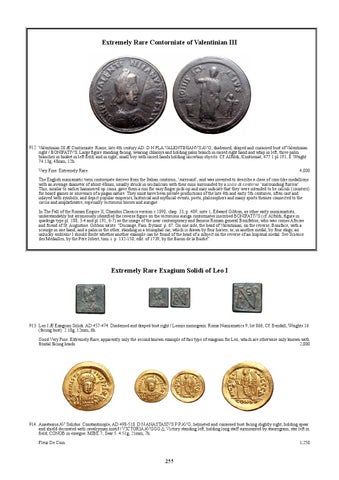Extremely Rare Contorniate of Valentinian III
912. Valentinian III Æ Contorniate. Rome, late 4th century AD. D N PLA VALENTINIANVS AVG, diademed, draped and cuirassed bust of Valentinian right / BONIFATIVS, Large figure standing facing, wearing chlamys and holding palm branch in raised right hand and whip in left, three palm branches in basket in left field, and in right, small boy with raised hands holding uncertain objects. Cf. Alföldi, Kontorniat, 477.1 pl.191, 8. Weight 74.13g, 48mm, 12h. Very Fine. Extremely Rare.
4,000
The English numismatic term contorniate derives from the Italian contorno, ‘surround’, and was invented to describe a class of coin-like medallions with an average diameter of about 40mm, usually struck in orichalcum with their rims surrounded by a solco di contorno ‘surrounding furrow’. This, similar to earlier hammered up coins, gave them a rim for easy finger pick-up and may indicate that they were intended to be calculi (counters) for board games or souvenirs of a pagan nature. They must have been private productions of the late 4th and early 5th centuries, often cast and inlayed with symbols, and depict popular emperors, historical and mythical events, poets, philosophers and many sports themes connected to the circus and amphitheatre, especially victorious horses and aurigae. In The Fall of the Roman Empire II, Chandos Classics version c.1890, chap. 33, p. 409, note 1, Edward Gibbon, as other early numismatists, understandably but erroneously identified the reverse figure on the victorious auriga contorniates inscribed BONIFATIVS (cf. Alföldi, figure in quadriga type pl. 188, 3-4 and pl 191, 6-7) as the image of the near contemporary and famous Roman general Bonifatius, who was comes Africae and friend of St. Augustine. Gibbon wrote: “Ducange, Fam. Byzant. p. 67. On one side, the head of Valentinian; on the reverse, Boniface, with a scourge in one hand, and a palm in the other, standing in a triumphal car, which is drawn by four horses, or, in another medal, by four stags; an unlucky emblem! I should doubt whether another example can be found of the head of a subject on the reverse of an Imperial medal. See Science des Medailles, by the Père Jobert, tom. i. p. 132-150, edit. of 1739, by the Baron de la Bastie”.
Extremely Rare Exagium Solidi of Leo I
913. Leo I Æ Exagium Solidi. AD 457-474. Diademed and draped bust right / Leonis monogram. Roma Numismatics 9, lot 866; Cf. Bendall, Weights 16 (facing bust). 2.18g, 12mm, 6h. Good Very Fine. Extremely Rare, apparently only the second known example of this type of exagium for Leo, which are otherwise only known with frontal facing heads. 2,000
914. Anastasius AV Solidus. Constantinople, AD 498-518. D N ANASTASIVS P P AVG, helmeted and cuirassed bust facing slightly right, holding spear and shield decorated with cavalryman motif / VICTORIA AVGGG Δ, Victory standing left, holding long staff surmounted by staurogram, star left in field; CONOB in exergue. MIBE 7; Sear 5. 4.51g, 21mm, 7h. Fleur De Coin.
255
1,250
